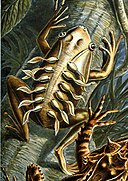Dosiero:Haeckel Batrachia.jpg

Grandeco de ĉi antaŭvido: 424 × 599 rastrumeroj. Aliaj distingivoj: 170 × 240 rastrumeroj | 339 × 480 rastrumeroj | 543 × 768 rastrumeroj | 724 × 1 024 rastrumeroj | 2 323 × 3 284 rastrumeroj.
Bildo en pli alta difino ((2 323 × 3 284 rastrumeroj, grandeco de dosiero: 2,17 MB, MIME-tipo: image/jpeg))
Dosierhistorio
Alklaku iun daton kaj horon por vidi kiel la dosiero tiam aspektis.
| Dato/Horo | Bildeto | Grandecoj | Uzanto | Komento | |
|---|---|---|---|---|---|
| nun | 03:17, 24 feb. 2006 |  | 2 323 × 3 284 (2,17 MB) | Ragesoss | improve version, based on same original scan |
| 00:22, 11 feb. 2006 |  | 2 318 × 3 280 (2,21 MB) | Ragesoss | The 68th plate from Ernst Haeckel's 1899 ''Kunstformen der Natur'', depicting frogs classified as Batrachia. Category:Ernst Haeckel |
Dosiera uzado
La jena paĝo ligas al ĉi tiu dosiero:
Suma uzado de la dosiero
La jenaj aliaj vikioj utiligas ĉi tiun dosieron:
- Uzado en arz.wikipedia.org
- Uzado en ast.wikipedia.org
- Uzado en az.wikipedia.org
- Uzado en ban.wikipedia.org
- Uzado en be.wikipedia.org
- Uzado en bg.wikipedia.org
- Uzado en ca.wikipedia.org
- Uzado en ca.wikibooks.org
- Uzado en ceb.wikipedia.org
- Uzado en ckb.wikipedia.org
- Uzado en dag.wikipedia.org
- Uzado en de.wikipedia.org
- Uzado en din.wikipedia.org
- Uzado en el.wikipedia.org
- Uzado en en.wikipedia.org
- Wikipedia:Featured pictures thumbs/04
- Wikipedia:Picture of the day/June 2006
- User:Ragesoss/Haeckel
- Wikipedia:Featured picture candidates/Haeckel Batrachia.jpg
- Wikipedia:Wikipedia Signpost/2006-03-13/Features and admins
- Wikipedia:Featured picture candidates/March-2006
- Talk:Frog/Archive 3
- User talk:Ragesoss/Archive1
- Wikipedia:Picture of the day/June 12, 2006
- Wikipedia:POTD/June 12, 2006
- Wikipedia:POTD column/June 12, 2006
- Wikipedia:POTD row/June 12, 2006
- Kunstformen der Natur
- User:Samsara/Frog/Stable
- Wikipedia:WikiProject Germany/Gallery
- User:Froggyyes~enwiki
- Wikipedia:Featured pictures/Animals/Amphibians
- Unclean spirit
- User:Xophist/s5
- Wikipedia:Wikipedia Signpost/2006-03-13/SPV
- Portal:Amphibians
- Talk:Alfred Russel Wallace/Archive 1
- Portal:Amphibians/Selected picture
- User:The Transhumanist/Sandbox144
- Template:POTD/2006-06-12
Vidi plian ĝeneralan uzadon de ĉi tiu dosiero.







